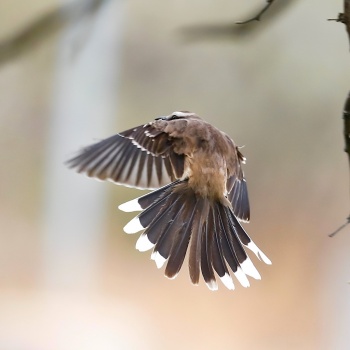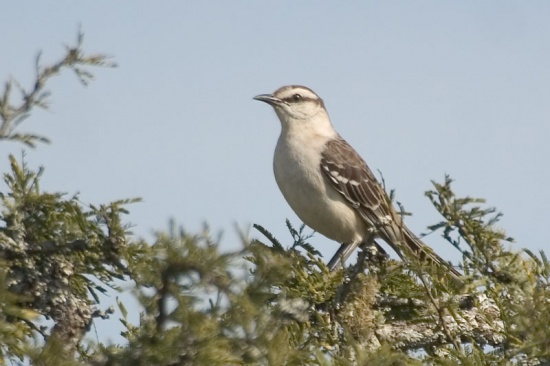- Mimus saturninus
Identification

El 44 Reserva Natural de Tiempo Libre north of Capilla del Monte, Córdoba Province, Argentina, 4 October 2019
23·5–26 cm (9¼-10¼ in)
This mockingbird has pale overall colour, with brown wings and tail. A brown stripe crosses its eyes as well. The bird has a chalk (clearer) eyebrow and the white tip on the end of its tail is easily noticed when in flight. Colour variations can happen due to local soils.
Similar Species
The Chalk-browed Mockingbird can easily be mistaken for its congener, the Tropical Mockingbird (Mimus gilvus). In the limited area of overlap (only in coastal Brazil), the Chalk-browed Mockingbird can be separated from the Tropical by its browner (less grey) plumage and its stronger post-ocular spot/streak (reduced in the Tropical).
Distribution
It is widespread and often common in eastern and south-central South America: found in north-east Brazil, Bolivia, Paraguay, Uruguay and northern Argentina.
Taxonomy
Subspecies
This is a polytypic species consisting of four subspecies[1]:
- M. s. saturninus:
- M. s. arenaceus:
- North-eastern Brazil (Paraíba, Alagoas and Bahia)
- M. s. frater:
- M. s. modulator:
Habitat
Mainly found in open and semi-open areas.
Behaviour
This bird is commonly found in flocks of up to 13 individuals. While walking on the ground or perched in branches, it often opens and closes its wings partially and rapidly, while singing. This territorial display is often done by the entire group.
Breeding
It's nest is parasitised by Shiny Cowbird.
Diet
Its diet consist basically of fruits and invertebrates, especially insects. Since the seeds are not digested, this mockingbird may help in the dispersal of some plants, e.g. orange and avocado.
Vocalisation
It is famous for its huge repertoire of songs and calls, including many imitations of other birds.
References
- Clements, J. F., T. S. Schulenberg, M. J. Iliff, S. M. Billerman, T. A. Fredericks, B. L. Sullivan, and C. L. Wood. 2019. The eBird/Clements Checklist of Birds of the World: v2019. Downloaded from http://www.birds.cornell.edu/clementschecklist/download/
- BirdForum Member observations
Recommended Citation
- BirdForum Opus contributors. (2025) Chalk-browed Mockingbird. In: BirdForum, the forum for wild birds and birding. Retrieved 26 April 2025 from https://www.birdforum.net/opus/Chalk-browed_Mockingbird
External Links
GSearch checked for 2020 platform.1




